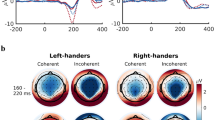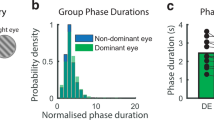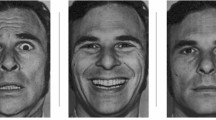Abstract
To study what might be called the ‘emotional vision’ of the right and left hemispheres of the human brain, a specially designed contact lens was used to show cine films to the right or left hemisphere only. Films were chosen to provoke different kinds of emotional response. We wished to find whether the two hemispheres would take and utilise the stimulus of the film to generate a different emotional response despite the common input. In recent years clinical and experimental data have supported the hypothesis that different emotional reactions follow damage to the right or the left hemisphere1–5. We report here the first part of an investigation in which films were perceived by different hemispheres in normal subjects and the subjects were then asked to judge and rate the films. There is of course no intention of suggesting that information implanted at one hemisphere cannot be transferred to the other6,7; nevertheless, the basis of this research is that the two hemispheres can differ in their vision of the world and that each in some respects formulates its own separate and distinct emotional vision of what it sees. We seek to answer the question of what visual experience is like when that which the subject sees enters his nervous system on only one half of his brain, but this is part of the much wider question of how the two hemispheres of the brain see the world and of the relationship between the two visual halves of the brain.
This is a preview of subscription content, access via your institution
Access options
Subscribe to this journal
Receive 51 print issues and online access
$199.00 per year
only $3.90 per issue
Buy this article
- Purchase on Springer Link
- Instant access to full article PDF
Prices may be subject to local taxes which are calculated during checkout
Similar content being viewed by others
References
Goldstein, K., The Organism—A Holistic Approach to Biology derived from Pathological Data in Man (American Books, New York, 1939).
Terzian, H., Acta neurochirurg., 12, 230–239 (1964).
Gainotti, G., Neuropsychologia, 7, 195–204 (1969).
Swash, M., J. Neurol. Neurosurg. Psychiatr., 35, 108–113 (1972).
Gainotti, G., Cortex, 8, 41–55 (1972).
Dimond, S. J., The Double Brain (Churchill Livingstone, London and Edinburgh, 1972).
Dimond, S. J., and Beaumont, J. G., eds, Hemisphere Function in the Human Brain (Elek Science, London and Halsted, New York, 1974).
Dimond, S. J., Bureš, J., Farrington, Linda, and Brouwers, E. Y. M., Acta Psychol., 39, 341–349 (1975).
Author information
Authors and Affiliations
Rights and permissions
About this article
Cite this article
DIMOND, S., FARRINGTON, L. & JOHNSON, P. Differing emotional response from right and left hemispheres. Nature 261, 690–692 (1976). https://doi.org/10.1038/261690a0
Received:
Accepted:
Published:
Issue Date:
DOI: https://doi.org/10.1038/261690a0
This article is cited by
-
Bi-hemisphere asymmetric attention network: recognizing emotion from EEG signals based on the transformer
Applied Intelligence (2023)
-
Relationship between Success in Motor Imagery of the Right and Left Hands and Users’ Personality Traits
Neuroscience and Behavioral Physiology (2022)
-
Generator-based Domain Adaptation Method with Knowledge Free for Cross-subject EEG Emotion Recognition
Cognitive Computation (2022)
-
The dynamic opponent relativity model: an integration and extension of capacity theory and existing theoretical perspectives on the neuropsychology of arousal and emotion
SpringerPlus (2015)
Comments
By submitting a comment you agree to abide by our Terms and Community Guidelines. If you find something abusive or that does not comply with our terms or guidelines please flag it as inappropriate.



